
Tim B
-
Posts
2,234 -
Joined
-
Last visited
-
Days Won
2
Content Type
Profiles
Forums
Blogs
Gallery
Events
Store
Posts posted by Tim B
-
-
Hi Tim...
Just out of interest, why do we all assume a second type from the same maker was/is a later shield. For instance...1 Million Krim shield's were awarded so at least that many were produced...probably close to 1.5 Million. So once the contracts were awarded, wouldn't a company like Deumer/Wurster/Orth make and run two or more die stamps at the same time...hence that's maybe why the designs are so close to each other.
Best...Peter
Hi Peter!
I assume the comment is general in nature and not specifically directed to this "type" Krim in this thread? If so, then..
Yes, entirely possible. I don't know the average life expectancy of a die that produces these type stampings but, remember that the Krim shield was initially authorized in July 1942 and the end date for awards in October 1943, though most probably were awarded by April '43. Most soldiers probably received a minumium of three shields for their uniforms and of course, there had to be some kind of after-market for replacements.
Now, considering all the different manufacturers that had license to manufacture these Krim shields (including all those different "unknown maker" varieties), would any one manufacturer need a long-term view of this one award with inclusive dates, and more than one die to fill that supply? ... Apparently, in the case of Deumer, Wurster, and to a lessor degree, Orth, it would appear those guys did.
It's estimated that only about 300,000 soldiers qualified for the Krim shield, so with 3-5 shields per man, that puts an estimate on the "demand" for around 1-1.5 million shields total. How the contracts were split I have no idea, but can only assume that Deumer, Wurster, and Orth (and maybe one or two that we don't know "who" yet) got more than the lions share compared to others like Josef Feix & Sohne, Maedicke, and some of those other "unknown" manufacturers ended up getting. That, based simply on the amount and type of shields we see available on the market today.
Now, would any of those manufacturers have put more than one die into operation at any gven time, I don't know, but it kind of seems unlikely to me as it would all be demand driven, again depending on life expectancy of the die IMHO.
Best,
Tim :cheers:
0 -
I think Dion nicknamed this one the T-Rex...never understood why. Not one of my favourites but I don't doubt it's originality.
KR...Peter
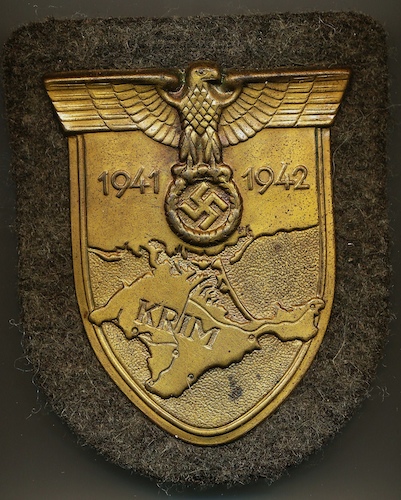
Hi Peter!
Yea, seems like it was the Russians that called it "flat-chested" and Dion thought the head looked like a dinsosaur (T-Rex). I can see it, then again, I have issues.


Tim
0 -
Phil,
I meant to add; I wouldn't give much concern to the fact Weber doesn't show this one (or any one for that matter) in his book, or that some on the Russian forums don't see these ground dug and thus, must be fakes. I have seen dealers and collectors alike hold on to stuff in their "inventory" and not show it as nobody else is showing like items. I don't know if it's fear of a piece being labled as "bad" or questionable, or if they just have doubt's themselves but, we see new revelations come up every year where something that was never seen before or considered not genuine, change status due to a new piece of evidence coming to light. Kind of makes you wonder what else is out there.
Major dealers only list a small portion of their actual inventory when updating and have lots of stuff in the back, that way they always have more to offer every week and like DeBeers, can control the flow of certain items and of course the price being asked. Classic supply & demand rules. Why do you think if you ask dealers to find you something, it usually doesn't take long to hear, "Hey! I found what you're looking for" (for a premium of course!).
This type of Krim was rarely seen a few years ago and now we see more and more. Either the "supply" is feeling more comfortable releasing them, or we are seeing a lot of fake items and made-up groupings that have these in them.
Tim
0 -
Mine has a really nice vault to it, does either one of yours?
Tim
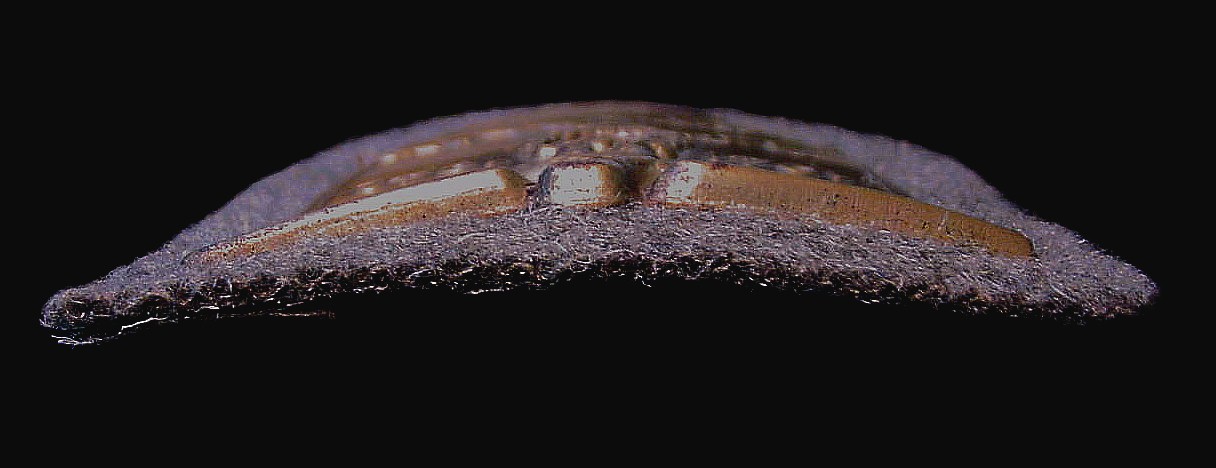 0
0 -
Note the rust on the eagle's head, shoulders and top surface areas.
Tim
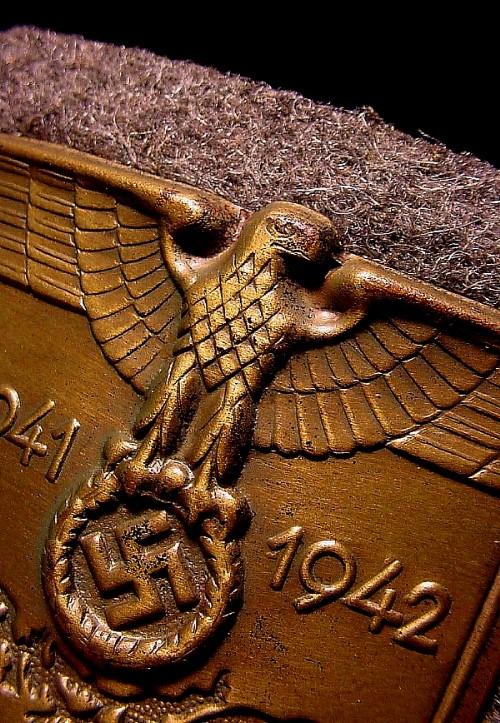 0
0 -
:lol:
Well grasshopper, sometimes we are so busy looking at the small things, we overlook the big ones. No big deal, I've done that sort of thing in the past as well.

Of all the shields of this particular style, I have only seen one or two that are really sharp in details throughout and I think (if the PICs are still there
 ) you can search WAF for the old threads.
) you can search WAF for the old threads.Here's mine, in pretty decent shape, though the details are just not pristine like most Krims, so exactly where in any timeline or if the die was never that well made..?
Tim
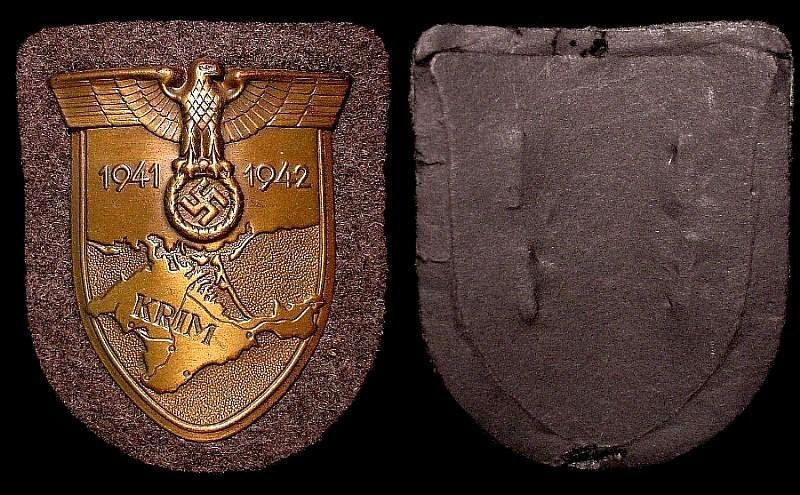 0
0 -
Hi Phil!
Umm, you sure your shields are made out of zinc? There appears to be a lot of corrosion (rust) on those two and zinc doesn't rust.

Tim :cheers:
0 -
Hey Tim,
I wouldn't even bother trying to find an original 1920 version. Hard copy of the current reprint book - US $20 from Amazon.
Rob
Hi Rob,
Really? Last time I checked Amazon, they didn't have it listed. $20, would be worth a hardbound book over a printed copy.

Tim
0 -
Hi Rob!
Oh, no doubt, my book gets used quite a bit as well, though I find myself looking at the Laslo/Nixon matrix's even more. Had thought about printing those out and pasting them into the back of the book.
My point on downloading the information from Google was simply it was free and you can print it out easy enough. It has some blank pages in it, but I figure about 57 pages front & back and you have the information for a lot cheaper and ... can you even find the actual hard copy of it? Not sure how much it will go for.
Tim
0 -
Andrei,
Okay, lots of shields posted and my eyes are not as young or as good as Phil's are. Some comments/questions on those you posted.
Again, you have some real beauties.

- I'm still undecided on the zinc Deumer you show in post #49. Just have too many doubts at this point.
- You show a Wurster shield in post #53 that is the first Wurster with the needle style pins that I remember seeing. Everything looks spot on to me.

- Can you show the Wurster in post #54 a little larger? It may be the shadows in the PIC that makes it look odd, but the head looks very different on this one compared to the other Wursters you have.
- You have a few unknown makers back to back and I assume you have more than just one or two of some of these shields as they look the same to me (?)
- In post #65, you show an unknown maker and I believe it to be the same type of shield I posted a PIC of in post #68. As far as I know, this is the only one with the larger holes in the backplate. The one you posted looks a bit different in the head, but again, it may be the PIC. Can you post a larger shot of this one as well? This is one that I am after and recently missed a rather nice one with the backing cloth and paper still on it.

Anyway, thanks again for posting all those and joining the discussion.

Tim
0 -
Hi Phil,
Yes, the "2" is most noteable, but also the "9" in 1941 and the both the "4" and "2" in 1942 appear very odd (mishapened) and almost look like they were hand manipulated IMO. These are the biggest concern for me.
Peter may know more on this one having it in-hand(?)
Interesting on the Orth/Unk shield write-up. Appears I am not too far off the mark noting the differences, but does Weber really go on to make an actual connection to the two? I don't get that based just on the page Peter posted.

Tim
0 -
Hi Rob,
You can actually download it for free through Google Books; it's about 129 pages in .pdf format.
Tim
0 -
Hi Tim...I agree, certainly a weak stamping, although I did show it to Pascal who considers it original.
Really!?
 Boy, I don't know about that one. I have seen some pretty nice looking shields that were supposedly copies and not copies of existing known shields, but completely different designs, but they were nice strikes. Why make a shield in such poor quality-strikewise?
Boy, I don't know about that one. I have seen some pretty nice looking shields that were supposedly copies and not copies of existing known shields, but completely different designs, but they were nice strikes. Why make a shield in such poor quality-strikewise?This one sort of reminds me of the shields shown in Weber's older book (pgs: 36 & 50). Though, I thought he now attributes one or both to Souval???
Tim
0 -
Hi Tim...I agree, certainly a weak stamping, although I did show it to Pascal who considers it original.
I meant to say regarding the new Krim book. worth buying but I wouldn't call it a 'complete work' on the Krim shield. It certainly misses a few makers out. In fact, I'm sure the 3 Deumers Sacha shows in his book are all from the same Die stamp (the flaw looks to be there in all the pics).
Here's a sample page...Peter

Hi Peter!
Hey, is this the same comparison I'm doing on the other thread "A New Krim"? I assume this is out of Weber's new book?
Tim
0 -
Hi guys!
Andrei, great collection!
 I would like to see some of those close-up for better looks.
I would like to see some of those close-up for better looks.Peter,
I don't know, the back certainly looks legit but, the front details not only look really soft but, the quality looks pretty poorly executed IMO. I originally thought it might be one of these below but, the coastline width under the wreath is definately different.
Tim
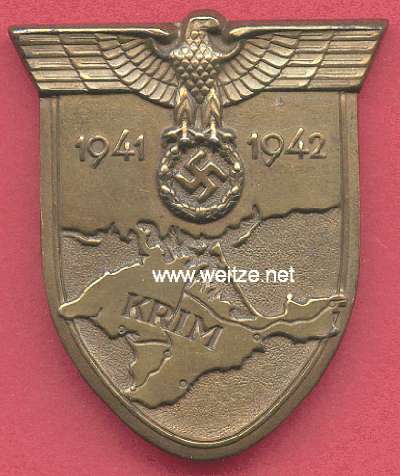 0
0 -
Hi Phil,
Thanks for your inputs and well thought out responses. Yes, I think you are right in your assessment here. We do not have a lot to substantiate this being attributed to Orth or anyone at this point and without something more concrete, would agree to keep this in the "unknown maker" column until we see/hear more on it.
As you stated, in cases like actual Orth, Wurster, or Maedicke examples where we see the maker's mark stamped on the shield and then compare other examples with the same, near identical die traits, its easier to follow. Even in the recent Deumer comparisons, we see examples off manufacturer's sample boards and can add things up to a resonable conclusion. Here, I just don't see it yet.
Any other opinions?
Tim
0 -
Hello Andrei,
Honestly, I just don't know. Your shield has some attributes I like, but the sharpness of details and the fact that some of those details are smaller, finer, and sharper, lead me to think either its one of the initial shields made, thus minimal wear and no die flaw, or its a really-really good copy.
I do understand and agree with the thought process of "if the piece was fake, then why haven't we seen more of these?" and I tend to follow that train of thought as well because its not cheap to develop and manufacture just one of something. No moeny in that. Then again, is this shield on the forefront of a bunch of new fakes just coming out? Probably not, if you have seen a few over the last couple of years.
I'll wait to hear more opinions from others. Wouldn't count it out at this point, but would be hesitant to lable it original as well.
Tim :cheers:
0 -
No, I believe the shield to be a copy Phil as the details are too sharp IMO. We hear about these laser-cut dies on badges now and it's possible this is a new one. I have seen examples (copies) in the past that have these really sharp ridgelines but not a Deumer style examples.
It would be interesting to know what material this one is made from.
Tim
0 -
Okay, that's what I got so far. I see some similarities and some differences. I really do not see enough for me to make an Orth connection though. Compared to other known examples where manufacturers made changes to their dies, the overall details remained the same, or so close, there was no question to who made it. This one is a bit of a leap for me. What am I missing?
There was a comment made on the Campaign shield discussion that Weber has this style listed in his book as a late Orth style as well. If so, does he elaborate "why" he thinks this?
Enjoy and don't be afraid to participate.

Tim
0 -
Finally, the "red" differences in the date numbers.
You'll see the numeral "1" is completely different with the top left leg on the Orth shield being much longer than the one I have.
The numeral "2" is more closed up as the top loops down on my example and has a small vertical leg before going horizontal, where as the Orth example does not.
The numeral "4" on my example has a unique shape. Note the curvature of the left upper arm and how it widens towards the top end. On the Orth example, all the lines are pretty straight and even throughout. The center vertical leg is also more tapered on the top tip on my example, though the Orth is slightly as well.
Tim
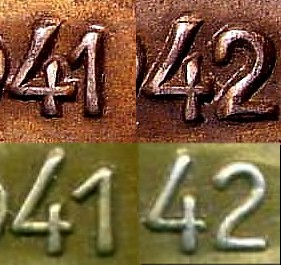 0
0 -
And again, as in the last post, the details are similar but the cut on the Orth shield is wider. Note the arrow points to a point in the coastline and it's much larger and more pronounced on the Orth shield as well.
Tim
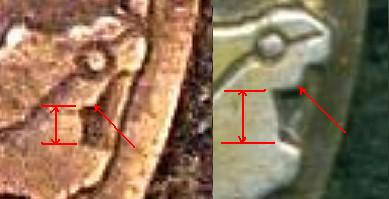 0
0 -
Now, towards the south or Black Sea area of the coastline. You'll note the shapes are similar but, the actual Orth shield is wider in the "bay" area.
Tim
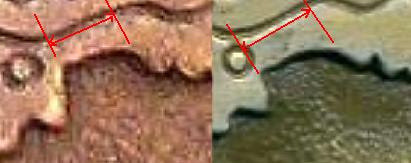 0
0 -
And my favorite area; what I often see as a dead animal on it's back with the limbs up in the air.
 I know, I have some issues.
I know, I have some issues. 
Anyway, the different makers can have a wide range of shapes in this area and in this case, they are similar but not exactly alike.
Tim
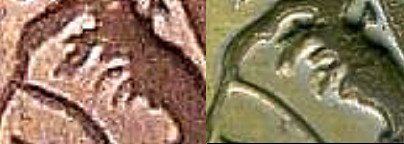 0
0 -
And some right coast details; again, very similar.
Tim
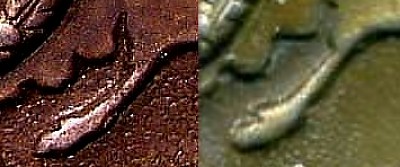 0
0


T Rex Krim
in Germany: Third Reich: State, Civil, NSDAP Awards & Decorations
Posted
Phil,
As far as I know, I have never seen a "T-Rex" version in zinc.
On the die questions; too many variables to answer without actually being able to talk to someone back then or find any records on the subject from those companies. Obviously, something that probably won't happen, as if those people are still alive today, they don't want to discuss that painful part of history or the role their companies had in it. So, we may never really know.
If we use Deumer as an example here:
- We see a major manufacturer that produced a wide variety of awards in all areas (Luftwaffe, Kriegsmarine, Heer, etc.) and in earlier metals as well as later zinc produced items. So, this manufacturer was in business for the entire period and clearly by the wide variety of items produced, given a large portion of awards contracts.
- Looking at the Krim shield though and IMO, counter to the thought of placing multiple dies in use simultaneously, we see a single die throughout (evidenced by an identical die flaw), and what clearly appears to be die wear progression from the more detailed head to the more rounded (worn) head of later models. Where the "flat-head" comes in, I can't say exactly at this point but wonder if this isn't another indication that it came earlier, prior to the wear in the head area and that die fault.
I also wonder if the attachments pins really make a difference or if they were just used as "available stock on hand". It's the shield die characteristics that make the difference as the pins were added later in the process. These manufacturers didn't care about what type of pins were used, they just needed something to connect through the cloth and backplate holes and bend over to secure the shield to the plate. They were covered up with backing paper and would eventually be covered upon sewing to a uniform anyway.
Perhaps, we as collectors, are reading too much into this small detail and both types of attaching pins were used throughout this timeline. This would make more sense why we see Deumer shields with the needle style pins and having the die wear and fault while appearing to be made later than those with the flat style pins. So, in short, perhaps both style were used simultaneously and as Andrei showed in the other thread, shields with a combination of pin styles existed as well. No transistion period, just stock on hand. Afterall, these were made as functional uniform accouterments, not collector items.
Keep in mind too, it's late 1942, going into 1943. America has just joined the war, there is no end of war in site and Germany has been in this fight for over three years now-hard! War materials are starting to get short and manufacturers are probably starting to feel the hurt as well. The order to switch over to zinc occurred during this period and perhaps everyone was starting to look at more cost-effective and efficient methods of producing these items like intregrating hinge and catches into badges vice separately attaching these items that had to be produced separately. Maybe this is where some switched over to the edge tabs on shields, intregrating the "attachment" method directly into the main shield design.
Food for thought!
Tim :beer: